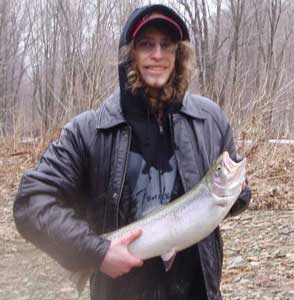Oncorynchus mykiss
(Walbaum, 1792)
Rainbow Trout & Steelhead
Above: A Steelhead I caught out of a tributary of the Ashtabula River, Ohio. Photo by Kim Cook.
Etymology:
Genus- Oncorynchus= hooked snout (Greek).
Species- mykiss= Russian vernacular.
Intro:
Oncorynchus mykiss is known as both the Rianbow Trout and Steelhead. Rainbows are landlocked as Steelhead are sea run rainbows. The fish are native to the Pacific Northwest.
Steelheads and Rainbow Trout are actually not true trout and more closely related to Salmon species.
In the Midwest this fish uses the Great Lakes as its ocean. The Great Lakes steelheads are all stocked by the DNR, but at one point there was a population that bred naturally in the Great Lakes. This population was wiped out by the Sea Lamprey.
Scientists argue whether this fish is a different species than rainbow trout, because of their sea run behavior. There are a few strains of steelhead, the most popular being the Skamina.
Habitat:
The fish are native to the Pacific Northwest. Steelheads are sea running Rainbow Trout and found out at sea and make spawning runs up the rivers in which they were born.
Spawning:
Steelhead are anadromous being a saltwater fish breeding in freshwater. They spawn in the rivers they were born in.
Great Lakes Steelheads normally spawn unsuccessfully. The reason is that many of the fry when in the rivers don't make it through the summer because the rivers or creeks get to hot.
Males develop a hooked jaw known as a kype during spawning.
Diet:
Steelheads and Rainbows feed on aquatic insects, eggs, and fish.
Size:
Steelheads and Rainbows are usually 18-24 inches and 2-6 pounds, but a 3 foot Steelhead can weigh 20 pounds.
Keeping In Aquaria:
Not possible due to size.
Gaming Qualities:
Steelheads and Rainbows are usually a tourist attraction. They are a prized fish to catch. Many fly anglers target them. This fish is a great fighter. They run hard and are a blast to catch.
Fishing Tips:
Fly fishing is a popular way to catch this fish, but they can be caught on spinning tackle. I like to use eggs or egg patterns during spawning. I usually drift fish for this species in rivers and creeks. For the Great Lakes and Oceans, trolling is usually the way to go.
